If you’ve ever ventured out through the rain showers and wind powers to the Great British coast, you’ll have probably been met with something a little different to the sublime visions of white sand and serene beauty often associated with beach geography.
In fact, you may have even found yourself regretting every step along the cobble-stoned pathways of the English, Scottish, Irish or Welsh coats believing the sand must be somewhere. And, in part, you’d be right. There are many beaches surrounding our little island that share soft sand such as Formby beach, but others like the Jurassic Coast in Dorset have a rainbow of stones and rocks that make for an entirely different beach holiday.
With this, you’ve probably come to the swift realisation that there are different types of beaches all around the world and are probably wondering what other beach types around the planet you’ve not yet seen or heard of. Again, you’d be right in the first instance. In the second, well, that’s why we’re here.
There are around 19 different beaches that have been so far identified on Earth and here at The Hobby Kraze, we’re excited to bring all 19 to your attention. From the glows of plankton washing onto shore in the night to the colourful sand types creating stunning illusions right before our very eyes.
But, just simply acknowledging and experiencing beach types around the world isn’t enough, so we’ll also be touching upon ways to appreciate and care for our environments so we can continue to bask in their glory for the future.
Take a look at what will be washing up onto shore in this article:
- What Makes Beach Geography and How Is a Beach Identified?
- All 19 of the Different Beach Types Around the World
- Things to Do on the Beach with Friends, Family and Loved Ones
- Ways to Keep the Coastline Clean, Tidy and Thriving
- What Are the Rules About Rock or Fossil Collection on Beaches?
When it comes to the beach getaway, you don’t always have to head to the coast. There are both saltwater beaches (where the land meets the open ocean) and freshwater beaches (formed with inland lakes or rivers).
Both of which can hold the properties of many of the 19 types of beaches simply due to the way a beach typically forms with the water current wearing away at the riverbed or ocean bed below. Meaning you can venture out into the wilderness to find both rocky beaches and sandy beaches at both the coast and the inland waterways.
Table of Contents
- 1 What Makes Beach Geography and How Is a Beach Identified?
- 2 All 19 of the Different Beach Types Around the World
- 3 Barrier Beach
- 4 Black Sand Beach
- 5 Boulder Beach
- 6 Fluorescent Beach
- 7 Green Sand Beach
- 8 Pebble Beach
- 9 Pink Sand Beach
- 10 Purple Sand Beach
- 11 Quicksand Beach
- 12 Red Sand Beach
- 13 River Beach
- 14 Saltmarsh Beach
- 15 Sea Cave Beach
- 16 Sea Glass Beach
- 17 Seashell Beach
- 18 Slate Beach
- 19 Underwater Beach
- 20 Urban Beach
- 21 White Sand Beach
- 22 Things to Do on the Beach with Friends, Family and Loved Ones
- 23 Ways to Keep the Coastline Clean, Tidy and Thriving
- 24 What Are the Rules About Rock or Fossil Collection on Beaches?
- 25 FAQs
- 26 Conclusion
What Makes Beach Geography and How Is a Beach Identified?

By definition, a beach is a narrow stretch of land that separates the waves of the water from any inland areas such as towns, roads, communities, etc.
They can be made of anything from fine grains of sand, to minerals, microorganisms, pebbles, rocks and even shells. However, what determines how a beach forms, and what the various different beach types around the world are, is geographical movement.
For example: harsh waters with soft sedimentary cliffs will leave caves or general beaches. Underwater currents can create new barrier islands and a push of sea debris can cause glass, shells, plankton and other things to wash up onto a shore and bring a rainbow of new classifications to the beach.
In short, most beaches are either made through erosion or accretion. They can be long, short, narrow, wide, tall, flat and separated from the land. All beaches have their own story, and each beach deserves a spot on the bucket list.
All 19 of the Different Beach Types Around the World

Typically, beaches form through the sediment and erosion of various different rock types as well as the mixture of marine life that can – sometimes – truly bring the beach to life. Discover which of the 19 beaches you will be putting on your bucket list after this ultimate guide to beach types around the world.
Barrier Beach

First on the list is the barrier beach. Technically a specific type of beach geography, how a beach forms a barrier is through a distinctive dune complex. They are also called sand bars and are formed with high tidal storms that bring strong underwater currents.
As the currents flow inland, they bring a swash of seabed sand that deposits near the shore. With this, they’re really common in low-level coasts such as the Gulf of Mexico. One of the best examples of a barrier beach is Isla Del Carmen just of the coast of Mexico.
Black Sand Beach

Black sand beaches are an example of how a beach forms with the use of volcanic materials such as the igneous rocks of basalt, andesite, granite and other silica-based sediment as well as iron oxide.
This mixture of rock is often pushed onto the shore from the oceans carrying deposits from nearby volcanic eruptions meaning these different beaches with black sand tend to be situated around active volcanoes such as Iceland’s black sand beach geography of Reynisfjara.
As they hold drying elements of iron oxide atop the absorption of all light, black sand can become very hot in the heat, making them nearly impossible to walk on while bare foot.
A fun fact is that the Icelandic people make a special rye bread called hverabraud (A.K.A. lava bread) by burying the dough in a tin under the black sand beaches while allowing the natural heat to bake the bread.
Boulder Beach
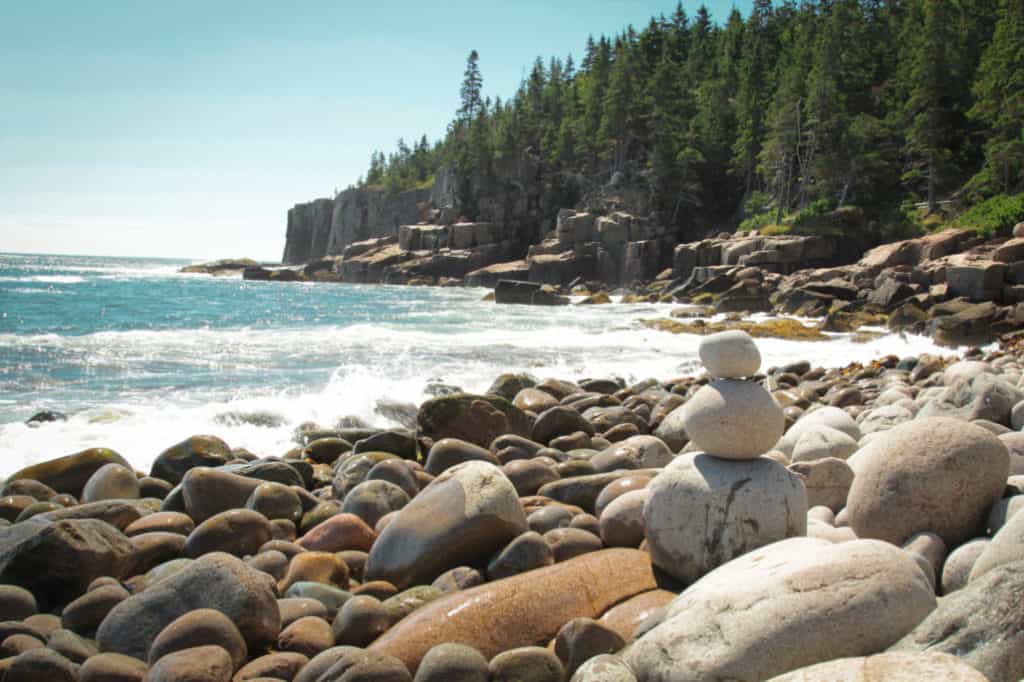
Ireland’s Giants Causeway is just one famous example of a boulder beach distinctive by the geometrical shapes of interlocking basalt columns. With this, the Giant’s Causeway is the only UNESCO world heritage site in Northern Ireland.
How a beach forms such magnificent columns is down to successive deposits of lava occurring over 50 million years ago.
Other boulder beaches, such as New Zealand’s Koekohe Beach filled with Moeraki Boulders have developed through years of coastal erosion that have left boulders of a different sedimentary makeup than other surrounding rock layers.
Fluorescent Beach
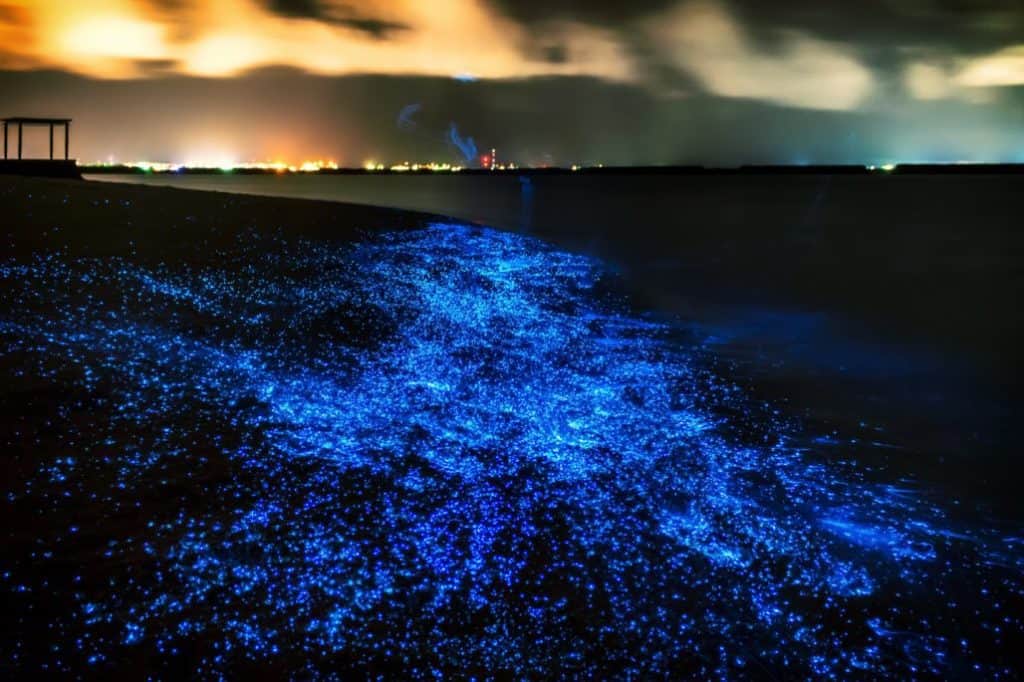
Fluorescent beaches, glowing beaches, blue beaches, bioluminescent beaches and any other similar names are all given to very special and – almost – magical types of beaches around the world. Such a beach is able to glow a bright blue on the shore under the moonlight.
Actually, there’s only one beach with the right beach geography in the entire world able to create this phenomenon. It’s called Mudhdhoo Island (yet is also locally known as Vaadhoo Island) and gains its glow-in-the-dark properties through a type of plankton that lives at the water’s edge.
If you head to the Maldives for an escape, you can’t miss the opportunity to swim in the glowing waters and then walk along the beach leaving unforgettable glowing footsteps behind you.
Green Sand Beach

Unlike the bioluminescence of the blue beaches, the beach geography that causes the surreal sight of a green sand beach is determined by the presence of a green-hue mineral named olivine mixed with black sand deposits and white sand deposits washed ashore by the tide.
Papakolea Beach (also referred to as Green Sand Beach) is a common example of a Hawaiian beach carrying green sand. However, it is one of only four green sand beach types around the world, with the others located in Norway, Guam and the Galapagos Islands.
Pebble Beach

Pebble beaches are the main cause of – shall we say – disappointment for young children arriving on a beach filled with small stones of non-playable ground after being told they’re heading for a day trip to the beach.
However, this shouldn’t be the case, pebble beaches, such as the many around the British coast, are beach geography marvels in themselves. These types of beaches are very referred to as shingle beaches. And, when we think about how a beach forms with pebbles, we think about the sheer power and force driving pebbles onto the shore such as Britain’s North Atlantic current.
They’re also a very popular spot for fossil hunting, fishing and other recreational seaside activities.
Pink Sand Beach
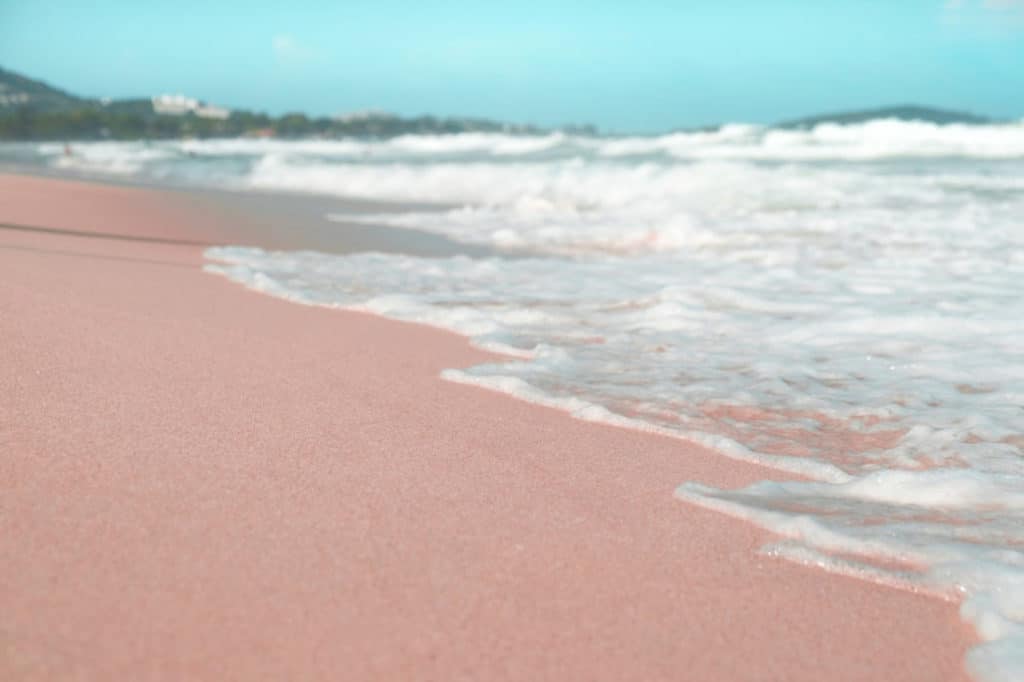
Crete’s Elafonisi Beach, Indonesia’s Pink Beach, Spain’s Playa de Ses Illetes, Bermuda’s Horseshoe Bay and the Bahamas’ Pink Sands Beach are all examples of some of the most spectacular natural phenomena to produce unmissable candy floss sands.
While many other hues of beach are given their colour by an organism or a mineral, the pink sand beach is a mixture of organisms and corals. The main colourant for how a beach forms pink sand is through a microscopic marine organism called foraminifera. Then, further reddish hues derive from washed up calcium carbonate deposits, shells and corals.
Purple Sand Beach
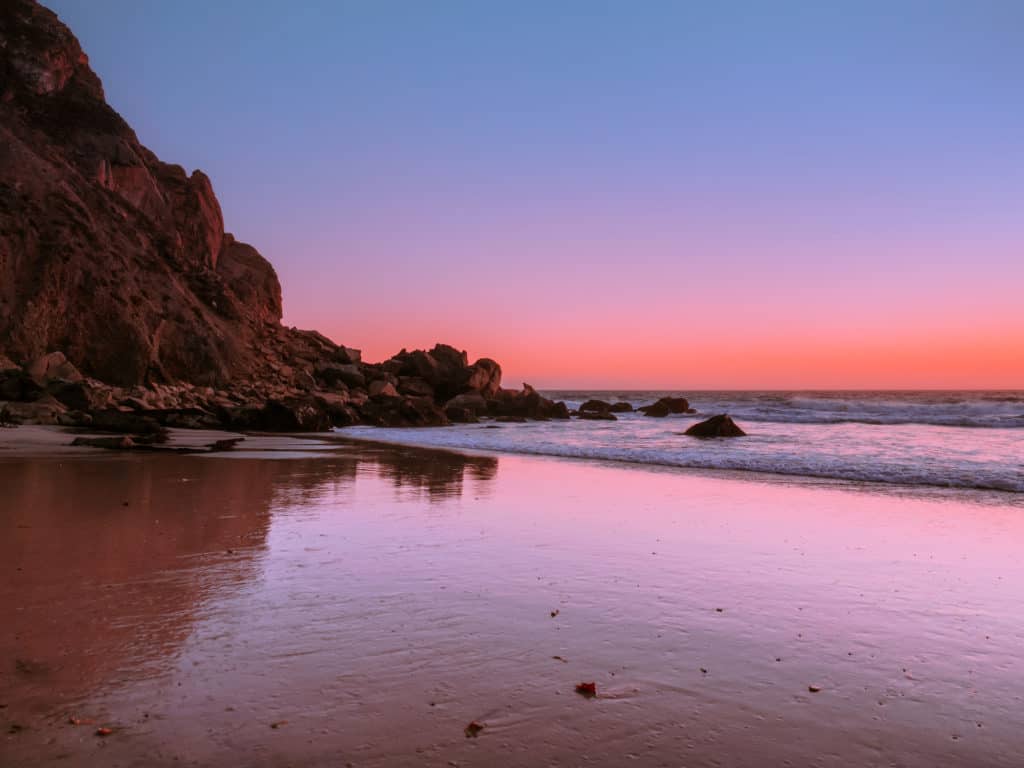
As with the other colours of the rainbow that adorn stunning beaches scattered across warm temperature destinations, the purple sand beach types consist of natural sediments such as manganese garnet.
Many of these purple deposits can be found closer inland near a cliff face as the sediments are washed ashore with the high tide. One of the most famous examples of beach geography with purple sand is California’s Pfeiffer Beach.
But it’s not the entire beach engulfed with glimmers of purple garnet. So, one of the best times to visit is the early sunrise where the rays catch the water’s surface and the surrounding purple sands to create a breath-taking view of a glass table drawing out into the horizon.
Quicksand Beach

A quicksand beach is a temporary state that can happen to almost all sandy types of beaches around the world. How a beach forms quicksand features is through the over-liquidation of the surrounding area. This creates liquefied soil and can be brought on by earthquakes or underground streams.
In simplified terms, when the ground (often sand or clay) is agitated and over-liquified, any vibrations can cause the already dispersed sand particles to move around far more flexibly than when dry and dense. Such vibrations (like an earthquake or from walking) allow the ground to separate and anyone walking above would appear to sink.
A top tip from the team here at The Hobby Kraze is to relax when caught in quicksand; movement can cause further sinking. However, as the body is less dense than the quicksand, it naturally floats when not moving.
Red Sand Beach

The red sand beaches are a product of a chemical reaction between natural iron levels in the rock sediment and the oxygen in the air. This causes a rusting effect that brings out the deep orange and/or red colour on the sands of a beach.
These sands can often be quite dry due to the iron oxide, so it’s suitable to wear something on the feet rather than braving the dash into the water and back.
One of the most famous examples, now often referred to as “The Red Beach” is Hawaii’s Kaihalulu beach.
River Beach

All rivers flow with gravity creating a natural current under the water’s surface that erodes the underlying riverbed. With this, it also erodes the embankment. And, depending on the sediment and ground layers, meaning the ground can erode from the top to create a sloped surface that can resemble a beach. Alternatively, it can erode a concave feature into the embankment which creates dangerous and unstable ground.
France is inundated with fantastic river beaches flowing throughout. From the St Aulaye river beach to Aubeterre sur Dronne, there’s all the luxury and relaxation of a beach with the added benefit of being close to the city, having a café and substantial toilets! As well as this, there’s no need to think about venturing out to the coastal regions or worry about the riptide.
Saltmarsh Beach

Also known as a tidal marsh, these coastal ecosystems feature greenery like no other. The beach geography for a saltmarsh relies on green cultures accumulating nearby a body of water with a tide or current.
Greens such as herbs and shrubs will thrive within silted mud. However, due to the landscape, high tides will engulf the greenery creating marshlands that erode any nearby rocks into loose sand and an open body of water will lead the eyeline into the horizon.
These are very common in areas such as Norfolk where fields of lavender are often met with waves.
Sea Cave Beach

A must visit sea cave beach is Praia de Benagil in Portugal. You’ll see why.
How a beach forms within a cave to create the different beaches underground is through the continuous force of crashing waves against and above a cliff face. Over time, the sedimentary rock wears away at varying degrees around the cave.
Eventually, this creates large scale inland caving. Inside which, the rocks below are also subject to consistent tides and waves that can wear down the soft rocks into sandy types of beaches.
Thus, the sea cave beach. With holes in the surface to let the sunlight beam down and holes in the front to let the waves crash onto the shore, each sea cave beach is more than unique with many forming hidden beaches such as Mexico’s secluded Playa del Amor.
Sea Glass Beach

California’s Sea Glass Beach, Bermuda’s Black Bay Beach, England’s Seaham Beach and Russia’s Steklyashka Beach are all famous examples of the glass beaches that have formed over the years of human industrialisation.
While beautiful and a sight to behold through each of the varied colours of sea glass glimmering across a beach, they have a dark story behind them. Sea glass is actually discarded and broken manmade glass that has been eroded by saltwater tides over the years. This creates smooth pebbles of translucent glass that are also known as mermaid’s tears around the world.
Green bottle glass, clear appliance glass, rare pink glass and more have all been a part of tourist marvel for years. With this, and the sheer reduction of glass disposal into the ocean means that sea glass types of beaches are a dwindling spectacle.
Seashell Beach

Just as it sounds, a seashell beach is a beach lucky enough to have millions of small seashells washed upon it. This is because of the marina cultures in the shallows nearby. With this, there are really only four destinations across the globe sharing this beach geography.
How a beach forms with this level of seashell mounding is simply due to the many crabs, snails, molluscs and other crustaceans that naturally pass, and the shells are carried by the current and waves onto the nearby shore.
With it being such a rare phenomenon requiring close-by marine cultures, the most famous seashell beach is – unsurprisingly – in Australia which is also home to the Great Barrier Reef.
Slate Beach

Wales is famous for many things like that train station with the impossibly long name (we’re still convinced anyone who claims to be able to pronounce it are making it up) and, of course, it’s capital Cardiff. Yet, one thing it has also been a hub for is slate.
The slate beaches at the North of Wales are a sight to behold and are a part of geological and historical significance. As metamorphous rock brought to the surface, 200 years ago it was mined by the Welsh for roof imports across Europe.
Underwater Beach
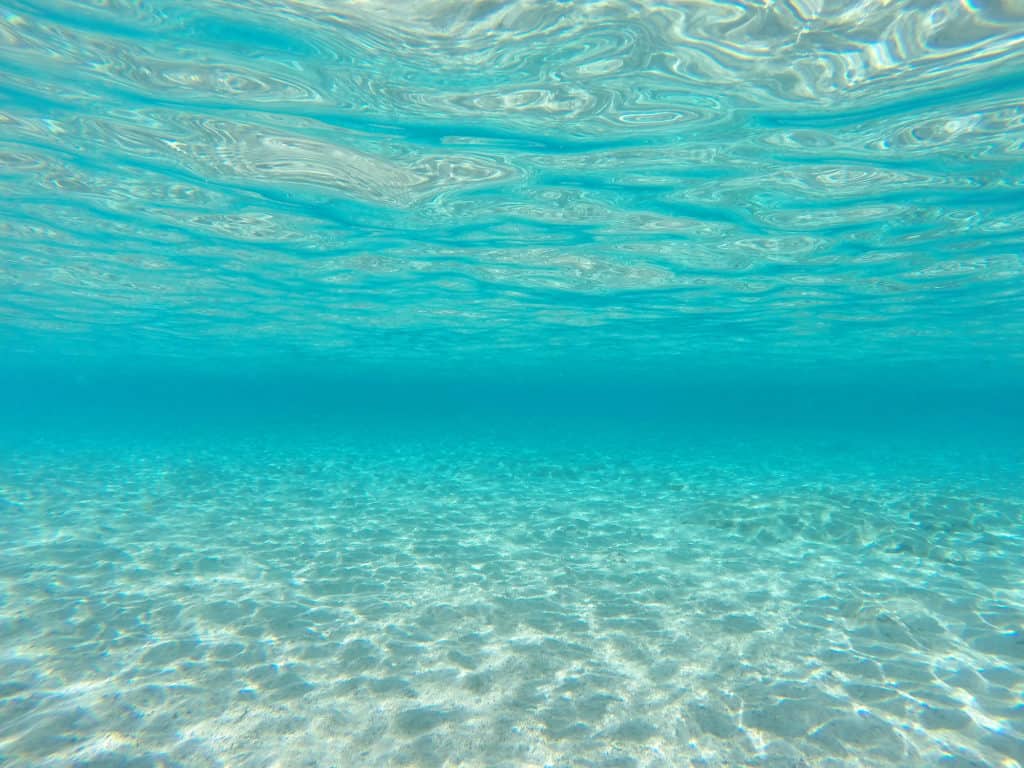
No, we’re not referring to the cartoon world featuring a specific yellow sponge and pink starfish with episodes seemingly featuring a beach. They’re actually real; you just won’t get to experience or see one in person.
An underwater beach (or often known as an underwater lagoon) is formed by the varied levels of salt, brine, temperature and other materials in the sea that determine the density. As such, dense and cold waters sit low to the ocean’s floor while the warmer and less-dense waters flow at the surface. And, when drastic changes of water density occur in the same place, you can see ponds, rivers and the accompanying beaches.
Urban Beach

The urban beach is a relatively new concept in human history, while naturally forming beaches have been around far longer than we have, we simply can’t get enough of them. So, much like creating manmade waterfalls and specially designed city garden scapes, we brought beach geography inland to landlocked cities or cliffside cultures who otherwise couldn’t enjoy the escape without literally escaping.
Examples such as Dubai’s Palm Jumeirah or the temporary transformation of the Pompidou Expressway in Paris’ Plages, show us how valued these fake beaches can be with umbrellas, loungers, beach bars and fountains to give a real feel of the ocean’s spray of water.
White Sand Beach

Finally, we have the white sand beach: the epitome of the beach getaway and the pinnacle of luxurious relaxation under the sun. They often offer the most soft and velvety feeling of sand under the toes while taking that breath of fresh air and looking into the horizon.
How a beach forms white sand is down to the erosion of the washed-up sediment of white quartz. With this, they’re often found in the warmer climates closer to the equator as quartz is an igneous rock formed by underwater volcanic action! Examples include the Caribbean Island beaches and the Maldives.
So, what are the different types of beach sand then?
| Type of Sand | Color | Composition | Locations |
|---|---|---|---|
| White sand | White | Quartz crystals | Caribbean, Hawaii, etc. |
| Black sand | Black | Volcanic rock | Hawaii, Iceland, New Zealand, etc. |
| Red sand | Red | Iron oxide | Prince Edward Island, Red Beach in Santorini, Greece, etc. |
| Pink sand | Pink | Shell fragments | Bermuda, Bahamas, etc. |
| Green sand | Green | Olivine crystals | Hawaii, Galapagos Islands, etc. |
| Shell sand | Varied | Broken shells and marine debris | Coastal areas worldwide |
| Coral sand | Varied | Coral and marine organism skeletons | Maldives, Great Barrier Reef in Australia, etc. |
Things to Do on the Beach with Friends, Family and Loved Ones

The beach is the place to go for outside adventures; come rain or shine, there’s always something for everyone to do. And it’s especially important to know that each beach geography can have its own special thing to offer.
For example, a pebble beach like the Jurassic Coast in Dorset is home to some of the best fossil hunting (hence the name). The slate types of beach in North Wales are best for seeking out new home décor and naturally occurring charcuterie boards with large pieces of unique slate. Then, the fluorescent beaches found in the Maldives are perfect for nature lovers wanting to watch organic matter of plankton shine their hearts out under the moonlight.
But, for more of the typical ways to enjoy the numerous different beaches on our little island and abroad, take a gander at this list our team has gathered together for you:
- Go hunting for fossils
- Use a metal detector to find hidden treasures
- Create sandcastles with the little ones
- Go snorkelling in the shallow waters
- Lay back on an inflatable (tethered to the beach!)
- Play frisbee with some strangers
- Camp out for the night in an eco-pod
- Get your volleyball team together
- Go for a walk along the coastline just to see where it leads
- Paddle with the family
- Catch a tan (with some factor 50!)
- Take a dip
To learn more about these amazing adventures on the coastline, have a look at our Ultimate Beginner’s Guide series here at The Hobby Kraze, with everything from “The Ultimate Beginner’s Guide to Scuba Diving and Snorkelling” all the way to “The Ultimate Beginner’s Guide to Ultimate Frisbee”, there’s something for you to enjoy after having learned all about how a beach forms.
Ways to Keep the Coastline Clean, Tidy and Thriving

According to the National Geographic, there is over 5.35 trillion tons of waste in our ocean, with much of it washing up onto shore and polluting our beaches. With this, we have bonus manmade beach types around the world: notably, the plastic beach. Once various natural types of beaches with much to offer to the eyes, coastlines in Bali, South Africa, Hawaii and beyond are all seeing their different beaches transform into plastic beaches with mounds of debris floating ashore.
Luckily, every little endeavour helps when it comes to our beaches and your efforts can make a difference too. So, when you’re enjoying your beach holiday, hopping between island paradise and rock-crashing wonders, have a think about these ten thigs you can do, so our families of the future can enjoy the sandy paths, too.
- Remove all your waste and rubbish from the beach front
- ‘Recycle, Reuse and Reduce’ where possible
- Take the initiative to clean the area of waste that isn’t yours
- Meal-prep your food with the right portion size in reusable containers
- Use environmentally friendly sun cream and other toiletry essentials
- Always clean up responsibly after pets
- Donate to charities and clean-up organisations
- Be a respectable traveller by walking and being cautious of marine life
- Never light a beach bonfire
- Take care of cigarette waste safely while removing other butts on the beach
What Are the Rules About Rock or Fossil Collection on Beaches?

While we may not be able to speak about the rules and regulations of all beach types around the world, we can touch on what is and isn’t allowed throughout the UK when it comes to rummaging through the sand and rocks to find natural treasures.
When it comes to finding metal treasures under the sandy dunes, there is a strict “Code of Practice for Responsible Metal Detecting” throughout England and Wales that you should abide by as well as the 1996 Treasure Act.
In the simplest of explanations, you need to hand over any ‘treasures’ dating back 3000 years and more to a find’s coroner for examination, you may be given a reward, but it truly goes to the owner of the beach geography. This being split between the Crown, the National Trust and the Ministry of Defence.
On the other side of the discovered coin is the finding natural riches of fossils and gemstones on the different beaches across the UK. Again, there’s typically the need to know the owner of the beach in order to go hunting as you’ll need permission. However, if you find something of potential geological, historical or archaeological significance, you’ll need to alert the owner of the beach and/or the local authority while leaving it behind in its natural habitat.
However, other pretty rocks, stones, coins and what-not from your venturing trove can be taken home, appreciated and crafted however you’d like.!
FAQs
What is a light up beach?
A light-up beach is a unique beach experience where the sand and water light up with bioluminescence. Bioluminescence is the production and emission of light by living organisms such as plankton, algae, and some marine animals. When these organisms are disturbed, they emit a blue-green light, creating a mesmerizing glow in the water and on the sand.
Light-up beaches are found in various locations around the world, such as the Maldives, Puerto Rico, and Australia. The best time to experience the bioluminescence is usually at night, when the darkness enhances the effect of the glowing water and sand.
What is a tidal beach?
A tidal beach is a type of beach that is affected by the rise and fall of the tides. Tides are the periodic rise and fall of the sea level caused by the gravitational pull of the moon and the sun. As the tide rises, it covers more of the beach, and as it falls, more of the beach is exposed.
Tidal beaches can vary in size, shape, and composition depending on the location and the strength of the tides. Some tidal beaches are wide and sandy, while others are rocky and narrow.
The tidal range, which is the difference in height between high tide and low tide, can also vary greatly from one location to another.
Tidal beaches can be found all over the world, from the coastlines of the Atlantic, Pacific, and Indian Oceans to the shores of lakes and rivers.
What is a storm beach?
A storm beach is a type of beach that is formed by the accumulation of large rocks and boulders that have been deposited by storm waves. Storm beaches are typically found in areas where the coastline is exposed to strong ocean currents and high-energy waves, such as on the Atlantic coast of North America and in parts of Europe.
Storm beaches can vary in size and shape, depending on the frequency and intensity of the storms that have affected the area. They can be composed of a range of different rock types, including granite, basalt, and sandstone. The rocks on a storm beach are often larger and more irregularly shaped than those found on other types of beaches, and they can create a unique and dramatic landscape.
To find out more about the unexpecting world of rock collecting and metal detecting through the Great British beach landscapes, have a look at these articles:
- The Ultimate Beginner’s Guide to Rock Collection and Tumbling
- The Ultimate Beginner’s Guide to Metal Detecting and Collection
- Can I profit from metal Detecting Findings?
- These Are the Rocks You Can Expect to Find Fossils In
Conclusion
And that solves all the questions you didn’t even know you had about the beach types around the world as well as the beach geography that helps us understand how these sandy enclaves came to be.
While it may not serve much as useful information, now you can understand how the sand beneath your toes was formed as well as it’s mineral make-up. Yet, we also now know how to treat our beaches with the respect and care that will keep each wave thriving onto the seaside for years to come.
To learn more about your adventures journeying across our plant, discover new ways to hobby, new ways to adventure and new ways to live with The Hobby Kraze. Don’t forget to share your thoughts with our team on social media; we love to hear about new hobby success stories, even if it does entail lounging on the beach front.
Sharing is caring!


